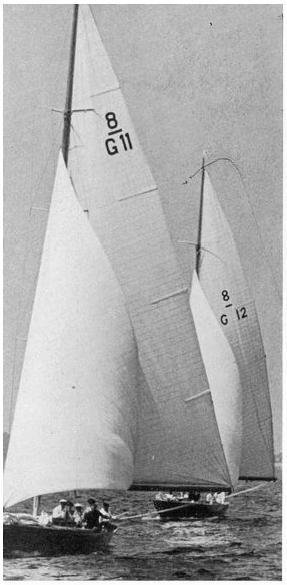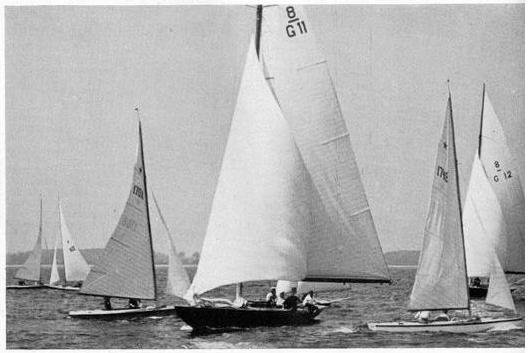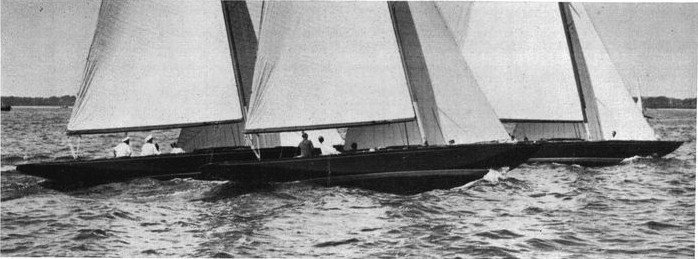Issue 16, April 1939
The German eight sailors are no less busy preparing for the coming last summer of sailing before the Olympic Games in Helsinki than the racing sailors in the other Olympic classes. Two new eights are certainly to be expected, one of which, a new "Germania" for Dr Krupp v. Bohlen und Halbach, is under construction at the Abeking & Rasmussen shipyard, the second at the same shipyard for the Berlin sailor Sponholz. The third new stern cannot yet be expected with certainty.
Issue 20, May 1939
Preparations are also in full swing among the aft sailors. It had become apparent that the modifications to the keel and rudder of the "Germania 3" that had been trialled in the two previous winters had not resulted in any improvements. The "Germania 3" was therefore rebuilt again and restored to its original condition. The new aft for the Berlin sailor Sponholz, which we reported on at the time, has since been launched at the Abeking & Rasmussen shipyard and has been given the name "Windsbraut". The owner has already started trimming in Kiel.
Issue 21, May 1939
Kiel spring regattas. In the eights, "Germania 3" also had to sail alone for the last two days, as the "Windsbraut" from Sponholz, which had just arrived, preferred trimming her sails to a hoped-for start.
Issue 24, June 1939
No standstill in the eights. Development in the Olympic 8m-R class had only seemingly come to a standstill. Structural changes had been made to our Olympic eight "Germania 3", which were expected to improve the boat. However, as the "Germania 3" had not improved as a result, the old condition was restored this spring and we now have a good comparison boat in this Olympic eight. In any case, this shows how hard work is being done quietly in this Olympic class. The "Germania 3" will meet the new "Germania" and the new Berlin "Windsbraut". The fact that, despite these two new constructions, only three eights will start during the Kiel Week, as in the previous year, says nothing at all with regard to the 1940 Olympic regattas in Helsinki. For these three German designs, the Kiel battles represent important preparatory work for 1940.
Issue 25, end of June 1939
Start of Kiel Week
Unsettled situation in the large R-classes. Of the two new German twelve-wheelers, the Hamburg "Sphinx", sailed by Brinkmann, and the Bremen "Aschanti 3", sailed by the owner Burmester himself, the "Sphinx" stood out not only because of its dark blue colour. The Hamburg ship was much better in trim, the sails stood up better and the crew was better trained. In contrast, the "Aschanti 3", which was only completed a few weeks before Kieler Woche, was only slightly trimmed and well-rehearsed. But even the "Sphinx", which won some of the first three fights by a very large margin - on Sunday she finished more than six minutes ahead of the "Aschanti 3" - does not yet seem to be in the best shape. However, it seems that the two new builds represent a significant improvement on last year's twelve. The Bremen "Aschanti 3", which had come second in the second race, did not start in the third race. The second places on the other two days went to the "Inga" and the "Anita", which had given up on the first day.
The same applies to the new eights, the Hamburg "Germania 4", which was steered by Walter v. Hütschler, the Star Boat World Champion, and the Berlin "Windsbraut 3" as to the twelve-oared boats. It is not yet possible to say what the situation is like for the German representatives of this largest Olympic class. On the first few days, the eights competed for the "Prize of the Reich Minister for Popular Enlightenment and Propaganda", which is sailed according to the victory system. But in these special prize races, no decision was made after the scheduled three races, as a different yacht won each time. On the first day the old "Germania 3", on Sunday the Berlin "Windsbraut 3" and on the last day the new "Germania 4". It was remarkable, however, that the eights fought a tough battle. Particularly on Sunday, the "Windsbraut 3" and the "Germania 4" fought for the lead in a very changeable way and finally crossed the finish line with a gap of only 13 seconds, while the old "Germania 3" was more than five minutes behind at the finish. In general, it can be said that the first Kiel Week battles were better trimming regattas for the twelve and eight.

Issue 26, beginning of July 1939
The big and the small on the outer courses.
Unfortunately, there were no foreign opponents in the battle of the proud twelve-boats, our four German boats remained among themselves, and there were no new opponents for the second part of the sailing week like last year. The performance of the boats in the battle with other boats will only become clear once they have started in the Scandinavian races. The big R-boats left Kiel harbour for the north on Sunday and Monday lunchtime. Every race raises new questions and clarifies old ones, we were told on board the "Aschanti". Every race brings new insights in terms of regatta technique and perhaps also in terms of design. The Brinckmann "Sphinx", which has won the last three days, has made the most progress with the trim of the sail, while the "Aschanti", which finished too late, was still working on the good position of the cloth. The boats are incredibly fast even in a light breeze. It is impossible to follow them with a slower motorboat. burmester's "Aschanti" made a colourful succession of prizes (I. 3. II. II. 4.) and "Anita" from Rau occupied the two free second places on Tuesday and Saturday, while "Inga" from Staatsrat Eßberger took this place on Thursday. Apart from the still superior "Sphinx", these races did not bring any clarification. The "Aschanti 3" was in second place in the points classification.
The Kiel Week cannot be used as a yardstick for the Olympic R-classes either, as the weather conditions do not allow it. If we only go by the results, then Dr Krupp's "Germania 4" is the best, provided that the Starboat World Champion v. Hütschler is at the helm. On the last day, however, he had the good fortune that Sponholz-Berlin's "Windsbraut", which had been leading for a long time, suddenly got stuck in a huge lull. The only first prize left for "Germania 4" was taken on Thursday by her older namesake with the owner's son at the helm. This victory, which was only achieved on the very last stretch of the course, was all the more pleasing as the Reichssportführer v. Tschammer und Osten sailed on board this boat in the blazing sun on this day, the last of his stay in Kiel. The Reichssportführer had a good idea of the difficulties involved in bringing a sailing vessel safely and as quickly as possible across the course. He expressed this impression eloquently in a letter to Vice Admiral Götting. The old "Vaterland" (Kröger-Warnemünde), now named "Sophie", was registered for the last few days, but she only managed a second place on the very last day of the calm.
The eights and starlings meet. The Berlin "Windsbraut 3" with Sponholz at the helm has fought its way back in front of the "Germania 4" (8G12).

Issue 30, August 1939
German successes in Helsinki
As we reported, a number of German boats in the Olympic classes took part in the races of the international Finland Week. Only the planned sending of several Olympic dinghy sailors to Helsinki had to be cancelled because the Finns had not announced the Olympic dinghy class. After the second place of the Kiel six "Gustel 8" behind the American "wonder six" "Goose" in the battles for the Gold Cup, which undeniably represents a great success, the German sailors also achieved successes in the Finland week. In the eights, the new Berlin "Windsbraut 3" with Sponholz at the helm achieved a third place and a superior victory.
The "Gustel 8", like the Berlin "Michel3", took second place behind the American "Goose". The "Gustel 8" also took fourth place. The star boat races were dominated by the German star sailors. They took at least the first two places in the four races. In the fourth race, there were even six German boats in the lead. The first two races were won by v. Reclam-Schlee from Berlin, the third by Telto from Berlin and the fourth by Blankenfeldt from Berlin. According to the newer scoring system, v. Reclam-Schlee was the best Star sailor; according to the old scoring system, Hansohm from Kiel was the best with two second, one third and one fourth place.
Issue 33, September 1939
Finland week on Olympic courses. The Gold Cup races were quickly brought to an end by America's triple victory. The rest days until the start of Finland Week provided a welcome opportunity to get the boats back into trim and enjoy the beauty of Helsinki and the archipelago. After the host nation Finland, Germany provided the most boats. Germany was represented by several boats in all Olympic classes, with the exception of the dinghies, which were not entered. There were two eights, four sixes and eight start boats at the start. Our Finnish sailing comrades greeted this strong German contingent with particular joy, which the commodore of the Nyländska Jaktklubben, Dr Ramsay, expressed in extremely warm words in his welcoming speech. The importance of the German expedition and the sympathy for the eager Olympic preparations of Finland, which is bound to us in friendship, were further emphasised by the dispatch of Schilling from the Reich Sports Office, who, as representative of the Reich Sports Leader von Tschammer and Osten, conveyed his greetings.
The German boats "Germania 4" (Krupp v. Bohlen und Halbach) and "Windsbraut 3" (Dir. Sponholz) competed in the 8 metre R class. Their opponents were the Finnish boat "Cheerio", the Latvian "Romance 3" and three Swedish boats, including the 1936 Olympic representative "Ilderim".
The first race was started on 22 July in a south-easterly of 7-8 m/sec. The courses had changed considerably compared to those of the cup races and were simple triangular courses with a length of 14 nm for the large classes. Although the German eights made an excellent start and impeccable spinnaker manoeuvres, they were still unable to assert themselves. This was particularly evident on the cross, where they could not really come to terms with the short, steep sea. On this day, the Swedes and Finns won unchallenged.
On the second day, the wind was blowing southeast again, but at 12-14 metres per second, which again created a short, steep sea. As it started to rain heavily during the race, the sailors were sure to get completely soaked. The same course as the previous day had to be sailed. The German eights were not superior to their opponents in this race either, even if they were able to keep up significantly better. For the time being, they still had to concede victory to their Swedish opponents.
The eights were able to improve from day to day and in the end even snatched victory from their initially superior opponents. With a fresh south-westerly wind there was finally an upwind start, and on this day the German boats were ahead in all classes at the start. The field of eights remained fairly closed on the cross, and the downwind leg did not bring any shifts either. On the rough passage to the finish, the balloon was sailed cleanly on both boats, and this persistent endeavour was rewarded with the third prize for "Windsbraut", while "Germania" came fourth. The winner was "Cheerio".
On all days the wind had been blowing more or less strongly, so that the races could be completed quickly. On the last day, however, the sailors once again had to savour the joys and sorrows of the doldrums race, in which the light, circulating winds demanded the utmost attention. A light westerly wind just got the boats through the start, only to fall asleep completely. Afterwards it turned to the south so that there was nothing to cross. The constant improvement in form of the eights was crowned by the victory of "Windsbraut", which had to represent the German colours alone on this day, as "Germania" had already set sail together with "Ilderim" to Sandhamn to take part in the Coppa d'Italia. "Windsbraut" did an excellent job. She was already second at the first buoy and caught up with her Swedish rival on the next course. After a fierce windward-leeward battle behind the last mark, she secured the windward position and pulled away unstoppably in the freshening wind to a superior victory.
Issue 47, November 1940: 3 eights on the Kiel Fjord
